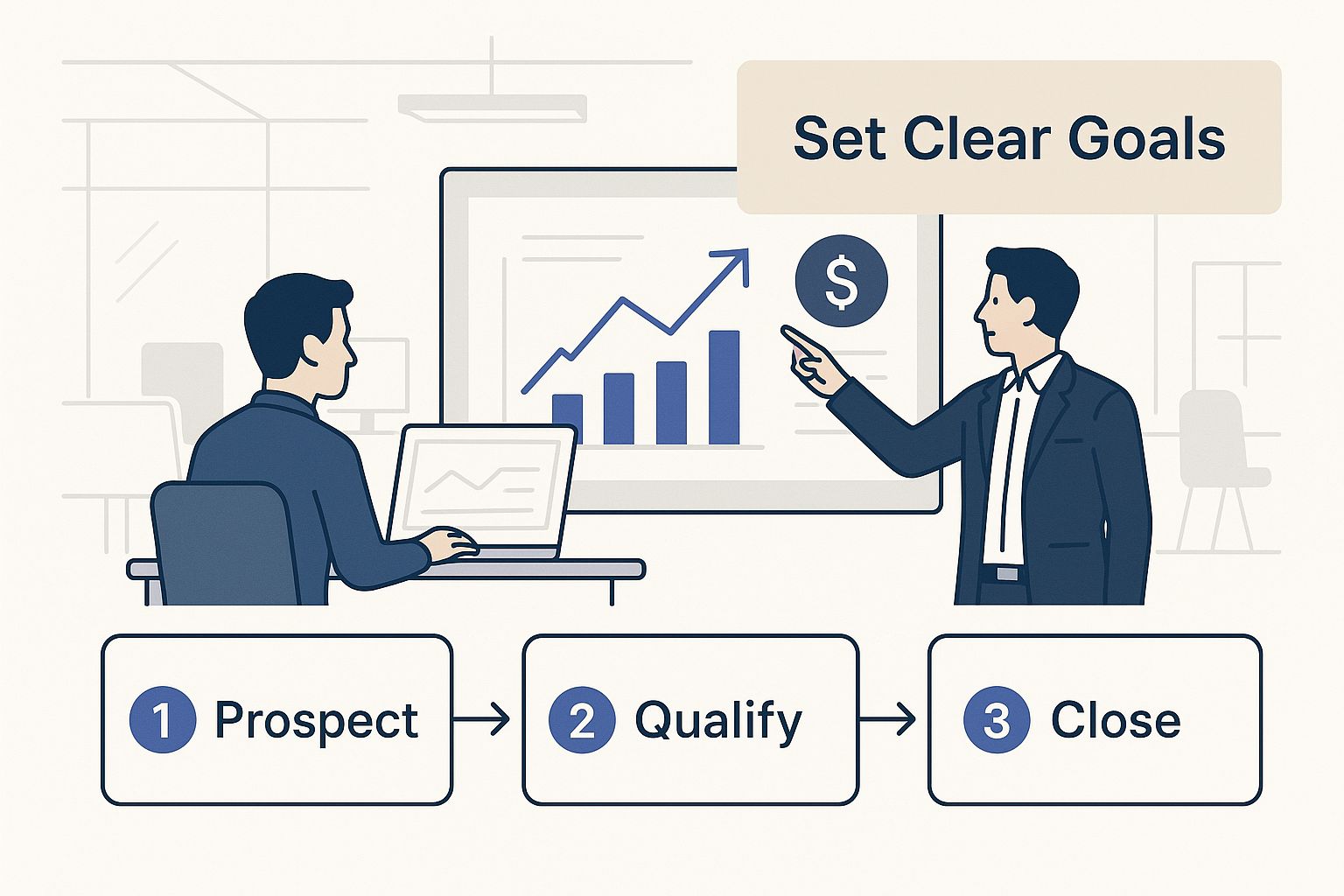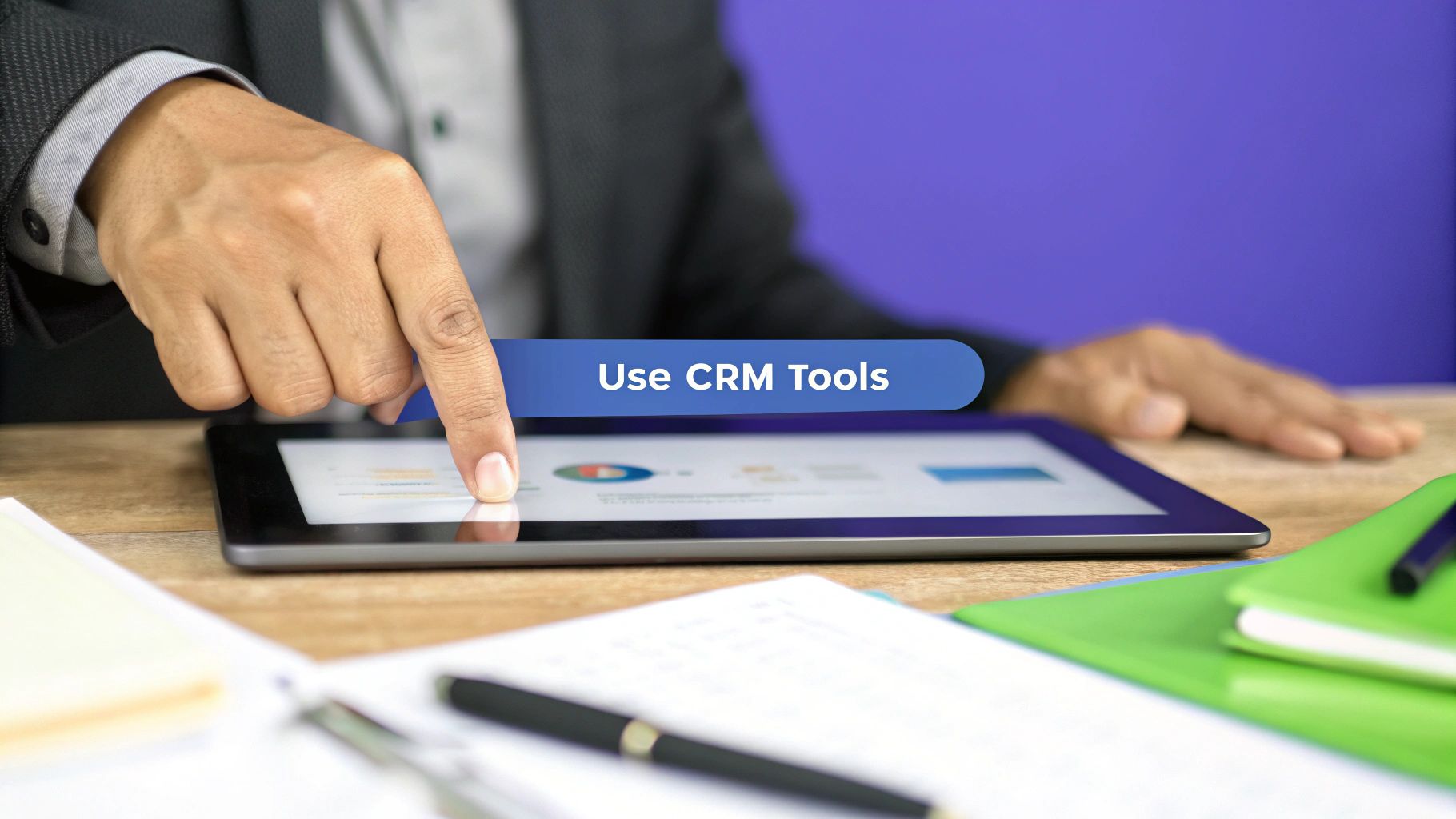How to Improve Sales Productivity: Top Strategies to Boost Performance
Learn how to improve sales productivity with proven tips on process, AI, and workflows. Boost your team's results today!

If you want to improve sales productivity, you have to start by looking at your current process. That means auditing your sales workflow to find and eliminate the hidden drags on your team's time.
The first step is to map out every action, from the moment a lead comes in to the second a deal closes. This is where you'll find the bottlenecks, the manual tasks that kill momentum, and the time-wasting activities that keep reps from selling. By getting a clear picture of where things get stuck, you can start building a repeatable process that works.
Auditing Your Sales Process to Find Inefficiencies
Before you can build a more productive sales engine, you need a blueprint of your current one. So many teams are running on old processes or informal workflows that have never been questioned. This is a recipe for reps wasting huge chunks of their day on tasks that don't move the needle.
The point of a sales process audit is simple: find the friction and fix it. You’re looking to create a smarter, more efficient path for your team to follow every time. This means tracking every handoff, decision, and action from lead to close.
Mapping Your Existing Sales Workflow
Get your team in a room with a whiteboard or a digital flowchart tool. Ask them to walk you through a typical deal, step-by-step. Where do leads come from? What’s the very first thing they do? What happens after that?
This exercise is incredibly revealing. You’ll almost certainly uncover major inconsistencies. Maybe one rep sends a welcome email right away, while another waits a day. One might follow a detailed qualification script, while another just wings it. These little variations add up, creating unpredictable results and making it impossible to know what’s working.
As you map out the workflow, keep an eye out for:
- Redundant Tasks: Are reps entering the same info into multiple systems?
- Approval Delays: Where do deals stall while waiting for a manager’s sign-off?
- Information Gaps: Do reps have to hunt down product sheets or marketing content?
- Manual Handoffs: How do leads get from marketing to sales, or between team members?
A sales process audit isn't about placing blame. It’s a collaborative effort to find the systemic issues that are holding everyone back. The real goal is to make everyone’s job easier and more effective.
Pinpointing Productivity Drains
Once you have your visual map, the biggest productivity drains will become obvious. They’re usually the administrative tasks that pull reps away from what they do best: selling. It's a well-known secret that reps spend a shockingly small part of their week on revenue-generating activities.
The data tells a sobering story. High-performing companies are twice as likely to have automated their sales processes. Yet, a staggering 66% of reps feel buried under too many different tools. This creates a paradox where the tech meant to help becomes a problem. It's not about having tools; it's about having the right tools, set up the right way. For a deeper look, you can explore various strategies to boost sales productivity.
This image shows a sales manager reviewing data on a dashboard, a perfect illustration of why setting clear, measurable goals is foundational to any productivity effort.

It highlights that you can't improve what you don't measure. Gaining visibility into team performance starts with having well-defined objectives from the get-go.
Redesigning for Simplicity and Action
After you've identified the problems, it's time to redesign the process. Your guiding principles should be simplicity and clarity. Every stage in your sales funnel needs a clear definition, a checklist of required actions, and a specific outcome.
For example, instead of a vague "Qualifying" stage, get specific. Define it with concrete actions:
- Initial contact call is made within 24 hours.
- Budget, Authority, Need, and Timeline (BANT) criteria are confirmed.
- Lead status is updated in the CRM to "Qualified."
This level of detail leaves no room for guesswork. It creates a standardized playbook that everyone on the team can follow, which makes your team's performance far more predictable and scalable.
By creating a clean, efficient, and repeatable process, you're building the foundation to improve sales productivity across your entire organization.
Using Automation to Accelerate Sales Workflows
So, you’ve spent time refining your sales process. What’s next? This is where automation comes in.
Think of it as a force multiplier for your sales team. Automation takes over the repetitive, low-value tasks that clog up their schedules and kill their momentum. This is a strategic move to give your reps back their most valuable asset: time.
When reps aren't bogged down by manual data entry or scheduling follow-ups, they can focus on what you hired them to do, which is to build relationships and close deals. The impact of this shift is huge, and there's a good reason why so many teams are leaning into it.
Identifying Key Automation Opportunities
The best way to start is by looking for tasks that are both time-consuming and rule-based. These are the perfect candidates for automation. You want to offload the predictable work so your team can handle the unpredictable, high-value conversations with prospects.
A few prime areas to look at are:
- Lead Scoring: Automatically assign points to leads based on their actions, like visiting your pricing page or downloading a case study. This helps reps immediately focus on the hottest prospects.
- Data Entry and Updates: Connect your web forms, chatbots, and other tools directly to your CRM. New lead information, meeting notes, and deal stage updates can be logged instantly, slashing administrative work.
- Meeting Scheduling: Get rid of the endless back-and-forth emails. A scheduling tool lets prospects book a meeting directly on a rep's calendar based on their real-time availability. Simple.
- Follow-up Reminders: Set up automated triggers that nudge reps to follow up with a lead after a certain period of inactivity. This ensures no opportunity falls through the cracks.
The goal of automation is to make human interaction better. By automating the mundane, you free up your team to have more meaningful, personalized conversations with potential customers.
The trend for automation isn't just a hunch; the numbers back it up. Data shows that 75% of organizations worldwide have already put some form of sales automation in place. Teams that do see a notable productivity bump, averaging around 14.5%. It's no wonder that 80% of sales pros believe automation is important for future success.
Building Smart and Seamless Workflows
Just flipping a switch on a new tool won’t cut it. Implementing automation requires thoughtful workflow design. A poorly planned automation can create more confusion than it solves, leading to a disconnected and frustrating experience for both your team and your customers.
For example, a solid workflow for a new lead might look something like this:
- A prospect fills out a "request a demo" form on your website.
- Automation instantly creates a new lead record in your CRM, populating it with the form data.
- The lead is automatically scored based on their company size and job title.
- A personalized welcome email is sent from the assigned sales rep.
- A task is created in the CRM for the rep to call the lead within the next two hours.
This entire sequence happens in seconds, without a single manual click. It guarantees a fast, consistent response every single time, which is a massive factor in converting new leads.
You can take these sequences even further by exploring how to apply automation across the entire customer journey. For a deeper look, check out our guide on sales funnel automation. It provides a framework for building connected workflows from initial contact to final sale. For another excellent resource, this guide to automating your sales process offers practical steps for real growth.
The key is to build a system where technology handles the process, and your people handle the relationships. That combination is how you accelerate your sales engine.
Once you’ve automated your internal sales tasks, the next logical step is to automate how you first talk to prospects. This is where AI-powered chatbots, like the ones we build at Chatiant, can become a game-changer for your sales team. Think of them as a tireless front-line crew, engaging website visitors 24/7.
A chatbot’s main job is to handle those first steps of lead qualification. Instead of forcing your sales reps to sift through every form submission or website inquiry, the bot can jump in. It asks targeted questions, gathers the necessary contact info, and can even book meetings directly on a rep’s calendar. Right away, your team is freed up to focus their energy on high-intent, sales-ready leads who are much further down the pipeline.
Designing Effective Chatbot Conversations
A great chatbot interaction is about creating a smooth and genuinely helpful experience. You need to map out the conversation flow based on what a visitor is actually looking for, making it feel natural and guiding them to a clear outcome.
For instance, a chatbot on a SaaS company's website might offer a few immediate paths:
- "I'd like to see a demo." This would kick off a scheduling flow where the bot confirms a few details, like company size or role, before sharing the right rep's calendar link.
- "I have a pricing question." The bot could provide a direct link to the pricing page or ask a couple of clarifying questions to point them to the right plan details.
- "I need technical support." This path would route the user over to the help desk or a support-specific bot, keeping your sales channels clear for actual prospects.
The trick is to anticipate what your users want and design specific, efficient conversational paths for each scenario.
A well-designed chatbot provides immediate value by answering questions quickly and guiding visitors to the next logical step. It’s often the first impression someone has of your brand, so making it a good one is key.
Connecting Your Chatbot to Your CRM
For a chatbot to truly level up your sales productivity, it needs to talk to your Customer Relationship Management (CRM) system. This is non-negotiable. This connection is what turns a simple conversation into actionable data, without anyone on your team having to lift a finger.
When a bot qualifies a lead, it shouldn't just fire off an email notification. It should automatically create a new lead record right inside your CRM.
This integration populates the record with everything the bot gathered: name, email, company, their role, and even the full chat transcript. The result? When a sales rep follows up, they have the complete context of that first conversation. No more redundant questions. The rep can start the conversation from a much warmer, more informed position.
The image below shows how a platform like Chatiant helps you build these AI agents, which are the brains behind your website's conversational experience.

This setup shows that creating a powerful, data-driven chatbot is accessible and doesn't require deep coding knowledge, making it a practical tool for just about any sales team.
Maintaining a Human Touch
One of the biggest worries people have with chatbots is creating a cold, robotic experience. I get it. But modern AI chatbots can be designed to maintain a human feel. It all starts with setting clear expectations. Let users know they're chatting with a bot but that a real person is just a click away if they need one.
The most important piece of this puzzle is designing a seamless handoff process. If a conversation gets too complex or a visitor asks to speak with a person, the bot should be able to instantly connect them to a live agent or provide contact details for the right department.
By combining the efficiency of AI with the empathy of your team, you get the best of both worlds. This approach helps you capture and qualify leads around the clock without sacrificing the quality of the customer experience. For more on this, our article on lead generation chatbots dives even deeper into these strategies.
Making Your CRM a Central Productivity Hub
Your Customer Relationship Management (CRM) system should be more than a glorified digital address book. When it’s humming along, it’s the command center for your entire sales operation, the single source of truth for every lead, deal, and customer conversation.
Too many sales teams let their CRM collect dust, treating it like a passive database instead of an active tool. A properly tuned CRM guides your reps, automates the tedious stuff, and gives you the data you need to make smart, strategic moves. It’s the backbone of a high-performing sales process.
Customize Your CRM to Match How You Actually Sell
A generic, out-of-the-box CRM setup rarely fits any business perfectly. The real magic happens when you tailor it to mirror the sales process you’ve already built. This means creating custom fields, pipelines, and deal stages that match the specific steps your team takes to close a deal.
If your process includes a “Technical Demo” stage, your CRM needs one, too. If you need to track a key qualifier like “Number of Employees,” that should be a custom field. This kind of setup makes the CRM work for your team, not against them.
Key customizations to consider:
- Custom Deal Stages: Align your CRM’s pipeline with the exact stages of your sales cycle. This gives you an accurate, real-time snapshot of where everything stands.
- Custom Fields: Add fields to capture the specific data points your team needs for better qualification, segmentation, and reporting.
- Automated Dashboards: Build reports that automatically track the metrics that matter most, like stage-by-stage conversion rates, sales cycle length, and rep activity.
A CRM that isn't configured to your sales process creates friction. Reps will have to invent workarounds, data gets messy, and productivity tanks. The goal is to make logging info and tracking deals completely seamless.
Drive Team-Wide Adoption and Keep Your Data Clean
A CRM is only as good as the data inside it. Simple as that. If your team isn't using it consistently, you're flying blind. Getting everyone on board is often one of the biggest hurdles, but it's absolutely necessary.
The secret is to show them what’s in it for them. When reps see how accurate data leads to better leads, smarter conversations, and faster sales cycles, they’ll be motivated to use it. Make it clear the CRM is there to help them succeed, not to micromanage their every move.
For a deeper look into this, there are great resources on making your CRM a central productivity hub.
Create a Unified Sales Ecosystem with Integrations
To turn your CRM into a true productivity engine, it needs to talk to the other tools your team uses every day. That’s where integrations come in.
By connecting your CRM to your email client, marketing automation platform, and other sales tools, you create a unified ecosystem where data flows freely between systems. This kills off the need for manual data entry, which is a massive time-drain. An email sent from a rep's inbox can automatically log in the CRM. A lead qualified by marketing can be passed to sales with its full history attached.
This creates a complete, 360-degree view of every prospect and customer.
The impact of a well-integrated CRM is hard to overstate. Recent research shows a striking 94% of businesses see a jump in sales productivity after bringing a CRM on board. These improvements aren't just minor tweaks; we're talking significant gains.
Take a look at what the data says:
CRM Impact on Key Sales Metrics
This table shows the average performance improvements reported by businesses after implementing a CRM system, based on recent studies.
These numbers, a 29% increase in sales and a 34% boost in sales productivity, show just how powerful a central data hub can be. And with a 42% improvement in forecast accuracy, it's clear that a good CRM doesn't just help reps, it sharpens your entire strategy. If you want to dig into these numbers, you can read the full research on these powerful CRM statistics.
Ultimately, a CRM becomes a strategic asset when it’s more than just a database. By customizing it to your process, making sure your team uses it religiously, and integrating it with your other tools, you turn it into the central engine that powers your sales team's productivity.
Tracking the Right Metrics to Measure Productivity
If you want to improve sales productivity, you have to measure it. But it’s easy to get lost in a sea of data, chasing vanity metrics that look good on a slide deck but don't actually tell you what’s working.
True productivity isn’t just about being busy; it's about being effective. To get a clear picture of what's really going on, you need to zero in on a handful of key performance indicators (KPIs) that reveal the health and efficiency of your sales engine. These numbers tell a story.

Go Beyond Surface-Level Numbers
Too many sales teams get hung up on metrics like the total number of calls made or emails sent. While activity is important, it doesn't always equal progress. Think about it: a rep could make 100 calls a day, but if none of them turn into qualified conversations, their productivity is close to zero.
Instead, let's focus on metrics that connect activity to actual outcomes. These are the numbers that give you real, actionable insights you can use to coach your team and sharpen your sales strategy.
Here are the important metrics to track:
- Lead Response Time: This measures how long it takes for a rep to follow up with a new inbound lead. In sales, speed is everything. A fast response time is one of the strongest predictors of higher conversion rates.
- Activity Volume Per Rep: This isn't just about total calls. It's about tracking the volume of meaningful activities, things like demos scheduled, discovery calls completed, or proposals sent out.
- Conversion Rates by Stage: This shows the percentage of deals that successfully move from one stage of your sales funnel to the next. It’s a powerful diagnostic tool for pinpointing exactly where deals are stalling.
- Sales Cycle Length: This tracks the average time it takes to close a deal, from the first touchpoint to the final signature. A shorter sales cycle is a strong signal of an efficient process.
- Customer Acquisition Cost (CAC): This one’s simple but very important. It’s your total sales and marketing costs over a set period, divided by the number of new customers you brought in. A lower CAC means you're growing more efficiently.
Using Data to Coach and Strategize
Tracking these metrics is just the first step. The real magic happens when you use this data to make smarter decisions.
For example, if you notice one rep’s conversion rate from "Demo" to "Proposal" is much lower than the team average, you have a specific, targeted coaching opportunity. You can listen in on their demo calls or review recordings to see where you can help them improve.
Likewise, if your overall sales cycle length starts to creep up, it could signal a bigger problem with your process. Maybe a new competitor just entered the market, or your pricing has become a major sticking point. Without the data, you’d just be guessing. With it, you can investigate the root cause.
For a broader look at improving your team's results, you might be interested in our guide on how to improve sales performance.
Data-driven coaching is far more effective than generic advice. It allows you to provide specific, targeted feedback based on real performance, which helps reps improve much faster.
Visualizing Your Metrics with Dashboards
Trying to make sense of all this data in spreadsheets is a recipe for a headache. This is where your CRM or a dedicated business intelligence (BI) tool becomes your best friend.
Set up a sales productivity dashboard that pulls your most important KPIs into one place. Use charts and graphs to make it easy to spot trends at a glance. A good dashboard gives you a clear, real-time view of your team's performance, letting you quickly identify both high-achievers and those who might need a bit of extra support.
When everyone can see the numbers, it creates a culture of accountability and continuous improvement. Reps can see how they stack up against their goals, and managers can make informed adjustments to their strategy. This is what turns guesswork into a clear path for driving productivity gains across the board.
Got questions about boosting sales productivity? You're not alone. Sales leaders and reps often run into the same roadblocks when trying to make their process more efficient.
Here are some of the most common questions we hear, with straightforward, practical answers.
What’s the Fastest Way to Increase Sales Productivity?
The single quickest way to get a win is to figure out where your reps’ time is actually going. You'd be surprised how much of the day gets eaten up by admin work, things like manual data entry, logging calls in the CRM, or just digging around for the right sales deck.
Pinpoint the top two or three biggest time sinks that aren't related to selling. Once you know what they are, you can use automation or a simple process tweak to solve them. This almost always leads to a fast, noticeable bump in active selling time.
For example, something as simple as an automated meeting scheduler or a tool that auto-syncs email activity to your CRM can instantly free up hours every week, for every rep.
How Can I Improve Sales Productivity Without Buying New Tools?
You can make huge strides without spending a dime on new software. The key is to zero in on process and training.
Start by standardizing your sales process and creating a playbook that’s easy to use. Make sure every rep is crystal clear on the deal stages and knows exactly what actions to take at each point. No more guesswork.
Next, double down on time management training. Introduce simple but powerful techniques like time blocking, where reps set aside specific hours for specific tasks like prospecting, follow-ups, and demo prep. Sharpening your internal handoffs between marketing and sales also cuts out a ton of confusion and delays, boosting efficiency with the resources you already have.
The most important metrics are the ones that directly tie sales activities to business outcomes. If you're tracking lead response time, sales cycle length, and conversion rates by funnel stage, you'll have a powerful view of both individual and team efficiency.
Which Sales Productivity Metrics Are Most Important to Track?
While you could track dozens of metrics, it’s far better to focus on a handful of indicators that tell you the whole story of efficiency and effectiveness.
If you’re only going to track a few, make them these:
- Percentage of Time Spent Selling: This tells you how much time is being lost to admin tasks. It’s a direct measure of efficiency.
- Lead Response Time: In sales, speed wins. Faster responses are directly correlated with higher conversion rates.
- Sales Cycle Length: This shows you how fast deals are moving through your pipeline from start to finish.
- Conversion Rate by Funnel Stage: This is key for spotting exactly where deals are getting stuck or falling through the cracks.
Tracking these four metrics gives you a complete, actionable picture of how to improve your team's productivity.
Ready to automate lead qualification and scheduling so your sales team can get back to selling? With Chatiant, you can build custom AI agents trained on your own data to handle front-line engagement 24/7. Explore what Chatiant can do for you.


